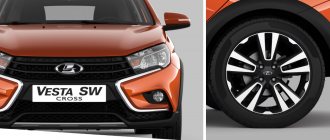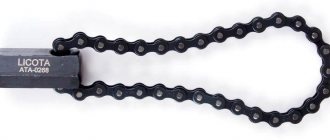VAZ presented the characteristics of its new cars for 2022 - Vesta universal. This model will be released simultaneously in two versions SV and SV Cross - that is, standard and off-road. Domestic-made cars will go on sale this fall.
The developers promise that this model will be a real breakthrough for the Russian market. In this body type, the Lada Vesta SV, the photo of which is presented below, will be next in price after the sedan of the same model. The current generation of Vesta is selling well on the Russian market, and after restyling it has every chance of becoming a real bestseller.
Exterior of Lada Vesta Cross SV
The design of the new Lada Vesta SV station wagon was developed by a team of specialists led by Steve Mattin. Every detail of the body is in harmony with each other, reminiscent of the “shark” theme in individual strokes. These features include the antenna “fin” located on the roof, as well as a plastic trim on the C-pillar, which becomes like a shark fin due to the visual gap with the roof. The narrowed pillars are in some places made in a black palette, which makes them invisible against the background of tinted glass. These details are successfully emphasized by the developers and complement the overall image. The car has a characteristic X-shaped style. Photos and videos are presented at the end of the review.
The roof also has a new shape, as it now has a significant slope towards the rear, which makes the car look like a representative of the sports class.
The dimensions of the Lada Vesta SV Cross fit exactly into the established framework of a platform sedan. The luggage compartment capacity, judging by the overall dimensions, is not much more compared to the four-door model. It has a lot of drawers for storing hand luggage, as well as additional fastenings. The volume is 480 liters when measured to the height of the curtain. In the floor under the lid there is a compartment with two removable trays, which adds another 95 liters. If you fold the back of the sofa, you can achieve maximum space with a usable volume of 825 liters.
Only the body height has become larger. In the Lada Vesta SV version, the parameters are increased thanks to the roof rails. She has them in black, while Cross has them in a metallic shade. The SUV has also added 2.5 cm thanks to the ground clearance, which is now 20.3 cm instead of 17.8 in the old variation.
In the Lada Vesta SV Cross, overall dimensions are not the only changes in the external design. The domestically produced vehicle is equipped with:
- 17-inch alloy wheels;
- protective plastic “skirt” around the entire perimeter of the body;
- original bumpers with imitation steel protection;
- stylish headlights;
- double exhaust pipe, which has a square cross-section;
- On the rear bumper there is a cutout for the muffler.
By the way, thanks to all the body kits, the off-road Lada SV has increased its length by 1.5 cm and its width by almost two, which can even be noticeable from photographs. The Cross has five seats, as well as doors. There is no video review from the test drive yet.
The developers tried to correct all the shortcomings of the Vesta sedan, in particular, the new cars will have an external trunk release button and a lockable gas tank flap.
Also included in the update is the color scheme. Now there is a new orange color, which is called Mars and is distinguished by its saturation. The black body kit highlights it favorably. A platinum color called Carthage has also been added.
Westonomics
Our auto industry has always taken a pragmatic approach to the creation of station wagons: cargo-and-passenger Muscovites, Volgas and even Chaikas were born in order to immediately become ambulance, delivery or ritual transport. For four decades, the universal Lada Zhiguli was dressed according to the patterns of the Fiat 124 Familiare model. And even the relatively modern “eleventh”, Priora and Kalina inherited this proletarian boxy style. And Vesta is sexy.
Why did former AvtoVAZ President Bo Andersson decide in the spring of 2015 to postpone the launch of the Vesta hatchback and focus on the version with a cargo-passenger body?
AvtoVAZ's initial strategy envisaged that a hatchback would appear after the sedan. But the five-door body needed a serious transformation (the rear overhang was supposed to be shortened by about 150 mm), and demand would have to be shared with the XRAY model. It is not surprising that Vesta Hatch was recognized as the weakest link.
But the concept of a station wagon with a unified floor from the sedan looked more logical. The body below the sill line required almost no redrawing, and the floor, the lower part of the trunk opening, the bumper and even the lights remained identical. True, with this approach it is problematic to make the trunk much larger than the original one (for the sedan it is 480 liters), and besides, a high threshold remains in the opening. And you also need to elegantly marry the “bottom” of the sedan with the new “top”. But here the experience of Steve Mattin, who spent most of his career in countries where any designer is ready to draw a “car” even with his eyes closed, came in handy.
Vesta Cross differs from the basic sedan and station wagon in its bumpers, protective apron around the perimeter of the body and suspension
— We didn’t intend to make Vesta a “cargo carrier”: that’s what Largus is for. Therefore, the result was an atypical station wagon - dynamic and sporty. This is a completely new segment for us, which has nothing to do with the “classics,” says Mattin.
By the way, for the same reason, the option of calling the Combi was not considered, despite the fact that, as in the case of the Granta-liftback, it would also suit Vesta. As a result, it was named in the Western style - Vesta SW, that is, station wagon, although no nameplates separately indicating versatility are provided.
Compared to the sedan, about 60 new parts have appeared in the body structure, including reinforcements, which should maintain body rigidity after removing the shelf behind the second row of seats. The frame of the rear door window has become higher (the opening has also increased), the roof is flatter, which means that, unlike the Vesta sedan, there should be an acceptable amount of space above the heads of the rear passengers. The C-pillars are angled forward almost like a hatchback, and the fifth door connector runs along the top of them, outlining a shark fin.
In terms of body length and width, the base station wagon is identical to the sedan, but 15 mm higher. Vesta Cross is raised by another 25 mm and slightly wider due to the wheel arches
As a result, looking at Vesta, it’s hard to escape the thought that the designers and marketers wanted to make not so much a roomy station wagon, but a compact SUV. This is especially noticeable in Vesta Cross.
The “cross” version will go on sale simultaneously with the base station wagon, from which it is distinguished by a plastic body kit, 17-inch wheels and ground clearance increased from the base 178 mm to 203 mm! Therefore, if an ordinary station wagon finds itself in a company with cargo-passenger versions of Ford Focus and Kia cee'd cars, each of which it is inferior in size, then the Vesta Cross can already be compared with the Renault Duster crossover: the Lada surpasses it in both length and ground clearance!
Interior features of Lada Vesta SV
According to the Lada Vesta SV, photo characteristics of the interior are not yet available, but the design will certainly trace aspects of the previous generation. For example, the interior will once again be decorated with colored inserts on the seats, doors and front panel. This makes the model of any configuration of the Lada Vesta SV bright, but may affect the cost. According to rough estimates, body kits, trims and other devices will cost more than 50 thousand rubles. But it is possible that such an additional payment will be quite justified.
The trim on the doors and panels and inserts on the seats are in the same tone as the body. A more relaxed interior can be made upon request.
The improvement has also reached the front panel. Now it has smoother shapes and has richer equipment. The instrument panel has improved LED lighting. The location of the controls for the multimedia system with navigation and seven-inch color display, as well as the climate control unit, has not changed.
Lada Vesta Cross SV: technical specifications
In most technical parameters and details, there is complete similarity with the sedan.
The Lada sports car is equipped with a 16-valve petrol engine with a volume of 1.6 and 1.8, distributed injection and four cylinders, which produces 106 and 122 hp. respectively, with a torque of 148 and 170 Nm. With its weight, it accelerates to 100 km in 11.2-13.3 s. The maximum speed reaches 172 and 180 km/h on different engines.
Cross SV is a car with front-wheel drive. The transmission is represented by a 5-speed robotic automatic transmission and manual transmission. A characteristic feature is the independent MacPherson-type front suspension, which has been modified to strengthen it. All brakes are disc. The steering wheel is adjustable and also has electric power steering. All-wheel drive equipment was never installed, although the model has off-road capabilities. The development of this project was postponed indefinitely due to circumstances and other costs.
It is worth noting the ease of access to all internal parts in case of repairs, for example, when replacing spark plugs.
The remaining technical parameters of the Lada wagon are presented in the table.
| Parameter name | NE | SV Cross |
| Length (mm) | 4410 | 4424 |
| Width (mm) | 1764 | 1785 |
| Height (mm) | 1512 | 1532 |
| Tire size | 185/65R16 | 205/50R17 |
| Wheelbase (mm) | 2635 | 2635 |
| Fuel tank volume (l) | 55 | 55 |
| Gasoline brand | AI-92 | AI-92 |
| Combined cycle consumption (l/100 km) | 7,5-7,9 | 7,5-7,9 |
It is possible to convert the car to a gas engine and use natural gas – methane – as fuel.
Technical description
Since there is no exact information about the release of a full-fledged modification of the Lada Vesta with all-wheel drive, it is too early to debate about the characteristics, economic benefits and other “successes”. It is quite possible that a reinforced sedan with a large engine capacity will simply be equipped with all-wheel drive. Let's try to figure out what this will give us further.
It’s hard to argue with the facts, as well as with the reviews of potential owners of the Lada Vesta Cross with all-wheel drive. Among the features the following points are positioned:
- the standard station wagon is a prototype with a slightly modified body and chassis;
- the engines remain virtually unchanged, producing the same 106 “horses” with a volume of 1.6 liters;
- the transmission unit remained in the form of a five-mode manual gearbox or robotic automatic;
- Perhaps some characteristics of the existing sedan will undergo changes, but there is no clear information on this yet.
Equipment
For the SV Cross the Luxe package is offered, for the SV - Lux and Comfort. Depending on the configuration, machines can be equipped with the following functions and systems:
- Electronic stability control with traction control option. This helps when starting on a hill.
- Front and front airbags (four in total).
- Three-stage heating of the front and rear seats.
- The driver's seat is height adjustable and has lumbar support.
- Heated windshield and windshield.
- Exterior mirrors are electrically heated and electrically adjustable.
- Automatic climate control system.
- Parktronic.
- Multifunction steering wheel.
- Cruise control system.
- Cooled glove box.
- Audio system.
- Rear armrest.
- Rear View Camera.
- Fog lights.
- Second floor panel.
- Luggage compartment organizer.
- Light and rain sensor.
In addition to the basic package, there are additional packages such as Multimedia, Prestige, Image.
Start of sales and cost
The release of the Lada Vesta SV Wagon series in the new version should start in the summer of this year, and the start of sales is planned for the fall. The standard model should be the first to hit the market, followed by the off-road model within a month. Serial production began on September 11. The price of the station wagon is higher than that of four-door models. The sedan today costs 545,900 rubles, and the SV Cross is much higher, as it has improved equipment. The price of a car starts from 755,900 rubles, depending on the configuration, which includes the choice of engine, transmission (automatic or manual) and package. The cost of SV starts from 639,900 rubles. Also, the cost may be higher due to the color of the body.
Will the Lada Vesta have all-wheel drive?
According to the general director of AvtoVAZ, sales of this vehicle are planned to begin in the first half of this year. Such information has brought inspiration and hope to many connoisseurs of the domestic automobile industry to replace the traditional station wagon with a compact SUV “locally produced.” Is this all so rosy? Let’s try to figure it out further.
To be fair, it should be noted that the plant’s engineers have made an application to produce an improved variation of the existing Cross vehicle, which will be equipped with two drive axles, an improved suspension and related elements aimed at improving the depreciation rate for off-road driving. If the promise is kept, the Lada Vesta with all-wheel drive has every chance of becoming one of the best representatives to come off the assembly lines of the domestic AvtoVAZ.











